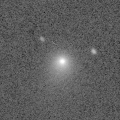
|
Now it is 8.6 mag (July 5, Juan Jose Gonzalez). It is expected to keep so bright as 6-8 mag for a long time from 2011 to 2012, and to be observable in good condition in the Northern Hemisphere. In the Southern Hemisphere, it keeps observable in good condition until October when it brightens up to 6.5 mag.
Date(TT) R.A. (2000) Decl. Delta r Elong. m1 Best Time(A, h)
July 9 22 32.75 4 51.1 1.974 2.674 123 8.7 3:28 (180, 50)
July 16 22 19.79 6 59.1 1.821 2.607 131 8.4 2:47 (180, 48)
|

|
It has returned after 27-year blank since 1984. Brightening very rapidly. Now it is very bright as 9.9 mag (July 6, Tsutomu Seki). It will approach to the sun down to 0.75 A.U. and brighten up to 10 mag in July and August. However, the condition of this apparition is bad. It locates extremely low, and only observable until mid July in the Northern Hemisphere. It locates extremely low and hard to observe in the Southern Hemisphere.
Date(TT) R.A. (2000) Decl. Delta r Elong. m1 Best Time(A, h)
July 9 5 0.38 31 17.2 1.607 0.891 30 12.0 5:37 (230, 0)
July 16 5 43.11 28 45.2 1.589 0.828 27 11.4 5:36 (235, -1)
|
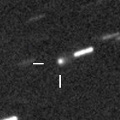
|
It will approach to the sun down to 0.5 A.U. in September, and it is expected to brighten up to 6 mag. Now it is 11.0 mag, brightening rapidly (June 29, Tsutomu Seki). In the Southern Hemisphere, it keeps observable until early September when it becomes 7 mag. In the Northern Hemisphere, it is already low and it becomes unobservable in August. But after appearing in the morning sky in October, it becomes observable in the excellent condition at midnight.
Date(TT) R.A. (2000) Decl. Delta r Elong. m1 Best Time(A, h)
July 9 10 51.85 5 53.6 1.726 1.427 55 12.7 18:32 (127, 33)
July 16 11 0.62 5 0.5 1.676 1.310 51 12.3 18:35 (122, 30)
|

|
It will be 12-13 mag in June and July. However, it is not observable at all due to the bad condition in this apparition.
Date(TT) R.A. (2000) Decl. Delta r Elong. m1 Best Time(A, h)
July 9 8 3.66 23 52.5 2.364 1.387 12 12.6 18:32 (113, -9)
July 16 8 29.06 22 57.6 2.375 1.395 11 12.7 18:35 (112, -9)
|

|
New comet. Very bright and visible visually as 12.8 mag (July 1, Juan Jose Gonzalez). It will brighten up to 11.5 mag in summer and autumn. In the Northern Hemisphere, it keeps observable until winter, although it becomes very low from mid August to late September. In the Southern Hemisphere, it is not observable until November.
Date(TT) R.A. (2000) Decl. Delta r Elong. m1 Best Time(A, h)
July 9 1 27.31 57 24.4 1.368 1.382 69 13.1 5:37 (186, -3)
July 16 2 17.90 64 57.6 1.307 1.298 66 12.7 5:36 (187,-11)
|
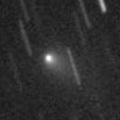
|
Now it is 12.4 mag and visible visually (June 29, Jakub Koukal). It will brighten up to 11-12 mag in autumn. In the Northern Hemisphere, it keeps observable for a long time until 2012 spring, although it becomes low temporarily in July. In the Southern Hemisphere, it is not observable until November.
Date(TT) R.A. (2000) Decl. Delta r Elong. m1 Best Time(A, h)
July 9 7 35.52 67 24.8 2.678 2.089 45 13.1 18:32 (153,-32)
July 16 7 41.17 65 24.5 2.672 2.064 43 13.1 18:35 (150,-34)
|

|
First return of a new periodic comet which brightened up to 13 mag in a major outburst in 2005. Now it is very bright as 12.0 mag and visible visually (July 5, Juan Jose Gonzalez). It will be observable in an excellent condition from summer to winter.
Date(TT) R.A. (2000) Decl. Delta r Elong. m1 Best Time(A, h)
July 9 23 16.93 -1 20.6 1.469 2.129 116 13.2 4:11 (180, 56)
July 16 23 19.53 -0 10.9 1.410 2.134 122 13.1 3:46 (180, 55)
|
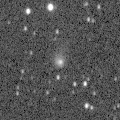
|
Now it is bright and visible visually at 13.1 mag (June 6, Chris Wyatt). It keeps bright as 13-14 mag for a long time after this until 2013. It is not observable in the Northern Hemisphere, but it is observable in good condition in the Southern Hemisphere.
Date(TT) R.A. (2000) Decl. Delta r Elong. m1 Best Time(A, h)
July 9 10 52.11 -76 53.2 5.262 5.606 104 13.5 18:32 ( 12, 44)
July 16 10 52.16 -76 11.0 5.294 5.594 101 13.5 18:35 ( 14, 43)
|

|
New comet. Very bright and visible visually as 13.1 mag (July 1, Juan Jose Gonzalez). It will be observable at 13 mag in good condition in summer. In the Northern Hemisphere, it keeps observable at 14-15 mag in good condition until autumn. In the Southern Hemisphere, it will become low after August.
Date(TT) R.A. (2000) Decl. Delta r Elong. m1 Best Time(A, h)
July 9 21 39.17 6 36.7 1.122 1.965 133 13.7 2:35 (180, 49)
July 16 21 13.58 12 35.8 1.066 1.950 138 13.5 1:42 (180, 43)
|
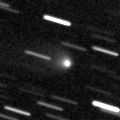
|
Now it is 13.2 mag and visible visually (July 5, Jakub Koukal). It will be observable at 13-14 mag for a long time from 2011 to 2012.
Date(TT) R.A. (2000) Decl. Delta r Elong. m1 Best Time(A, h)
July 9 19 19.61 -5 50.3 4.576 5.557 163 13.9 0:15 (180, 61)
July 16 19 10.25 -6 12.6 4.556 5.537 163 13.9 23:33 (180, 61)
|

|
Now it is bright as 12.5 mag and visible visually (June 23, Chris Wyatt). It is getting lower in the evening sky. It will be unobservable in early July in the Northern Hemisphere, or in mid August in the Southern Hemisphere.
Date(TT) R.A. (2000) Decl. Delta r Elong. m1 Best Time(A, h)
July 9 10 57.76 0 23.6 6.715 6.258 59 14.1 18:32 (124, 38)
July 16 11 1.30 0 3.2 6.807 6.259 53 14.1 18:35 (118, 34)
|

|
Big asteroid discovered in 1906. It suddenly showed the cometary activity on Dec. 11, probably due to an impact of a small object. It was very bright as 11.5 mag visually (Dec. 17, Juan Jose Gonzalez). It had a dust coma still on Jan. 9 (Joseph Brimacombe). Now it is stellar at 13.8 mag (Apr. 5, Juan Jose Gonzalez). It is getting lower in the evening sky, and will be unobservable in August.
Date(TT) R.A. (2000) Decl. Delta r Elong. m1 Best Time(A, h)
July 9 10 30.61 22 11.6 3.378 2.770 45 14.6 18:32 (135, 17)
July 16 10 40.60 20 57.8 3.427 2.758 42 14.6 18:35 (130, 15)
|
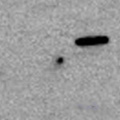
|
Now it is 15.2 mag (June 24, Hidetaka Sato). It brightens up to 12 mag in autumn. But the condition is bad. In the Northern Hemisphere, it is already low, and it will be unobservable in August. After the perihelion passage, it is only observable from December to February in the evening very low sky. In the Southern Hemisphere, it keeps observable for a long time, although it keeps locating extremely low. The component B was not detected, fainter than 20 mag (May 14, Hidetaka Sato).
Date(TT) R.A. (2000) Decl. Delta r Elong. m1 Best Time(A, h)
July 9 10 23.10 18 47.9 2.189 1.636 44 14.9 18:32 (131, 19)
July 16 10 37.23 17 0.9 2.169 1.570 42 14.6 18:35 (126, 18)
|
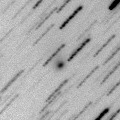
|
Now it is fading slowly, but still bright and visible visually as 13.7 mag (July 7, Jakub Cerny). It will keep 14-15 mag until mid September.
Date(TT) R.A. (2000) Decl. Delta r Elong. m1 Best Time(A, h)
July 9 23 53.95 3 34.2 2.600 3.045 106 15.0 4:48 (180, 51)
July 16 23 50.12 1 15.0 2.519 3.086 114 15.0 4:17 (180, 54)
|

|
Already bright and visible visually at 14.6 mag (July 6, Jakub Cerny). It will be observable in good condition at 12 mag in autumn and winter.
Date(TT) R.A. (2000) Decl. Delta r Elong. m1 Best Time(A, h)
July 9 23 46.35 5 27.9 1.999 2.495 107 15.3 4:41 (180, 49)
July 16 23 51.30 6 7.8 1.892 2.466 112 15.0 4:18 (180, 49)
|

|
It has brightened in outburst up to 14 mag in 2006 January. Another outburst occured in late May, and brightened up to 14.3 mag (June 4, Juan Jose Gonzalez). It is still bright as 14.5 mag (June 27, Jakub Koukal).
Date(TT) R.A. (2000) Decl. Delta r Elong. m1 Best Time(A, h)
July 9 16 4.67 -16 7.7 7.656 8.415 135 15.1 20:56 (180, 71)
July 16 16 3.42 -16 6.7 7.721 8.396 128 15.2 20:28 (180, 71)
|

|
It brightened rapidly and reached up to 15.4 mag now (June 30, P. Dupouy). It will be observable at 15 mag in good condition from July to October. It locates somewhat low in the Northern Hemisphere.
Date(TT) R.A. (2000) Decl. Delta r Elong. m1 Best Time(A, h)
July 9 20 39.95 -18 55.0 1.392 2.369 158 15.4 1:35 (180, 74)
July 16 20 36.72 -20 3.3 1.358 2.358 166 15.3 1:04 (180, 75)
|
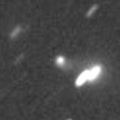
|
Now it is 14.8 mag and visible visually (July 5, Jakub Cerny). It keeps 15 mag from 2011 summer to 2012 summer. But it is not observable around the perihelion. It is observable in good condition in the Northern Hemisphere in 2011, and in the Southern Hemisphere in 2012.
Date(TT) R.A. (2000) Decl. Delta r Elong. m1 Best Time(A, h)
July 9 13 20.80 20 38.2 2.849 2.931 84 15.4 18:32 (175, 34)
July 16 13 26.10 19 15.3 2.882 2.887 80 15.4 18:35 (167, 35)
|

|
It is expected to keep 14-15 mag for a long time from 2011 summer to 2012 summer. The condition is good in the Southern Hemisphere, and it keeps observable for a long time. In the Northern Hemisphere, it is observable in the low sky in 2011 spring. But after that, it is not observable until 2012 August. However, this comet was observed only during two days in 2010 June. So the orbital elements are extremely uncertain.
Date(TT) R.A. (2000) Decl. Delta r Elong. m1 Best Time(A, h)
July 9 16 48.35 -48 13.4 2.421 3.280 141 15.6 21:39 ( 0, 77)
July 16 16 33.76 -49 9.6 2.437 3.229 134 15.5 20:57 ( 0, 76)
|
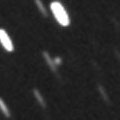
|
Brightening rapidly. Now it is 15.4 mag (June 25, Tzec Maun Observatory, Mayhill). It was observed as bright as 14.0 mag visually (June 27, Jakub Koukal). It is expected to be 13 mag and will be observable in good condition in 2013. In the Northern Hemisphere, it keeps observable for a long time after this. It is not observable in the Southern Hemisphere.
Date(TT) R.A. (2000) Decl. Delta r Elong. m1 Best Time(A, h)
July 9 2 6.40 59 57.9 7.945 7.552 63 15.7 5:37 (190, -7)
July 16 2 5.03 60 42.3 7.840 7.523 68 15.6 5:36 (187, -6)
|
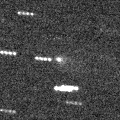
|
Now it is 15.5 mag (July 1, Hidetaka Sato). It will be fading gradually, and will be fainter than 18 mag in September.
Date(TT) R.A. (2000) Decl. Delta r Elong. m1 Best Time(A, h)
July 9 0 26.65 -11 47.7 1.745 2.230 104 15.9 5:21 (180, 67)
July 16 0 29.92 -12 5.0 1.707 2.271 110 16.1 4:57 (180, 67)
|

|
Now it is 15.0 mag (June 26, Tzec Maun Observatory). Brighter than originally predicted. It will be observable at 15-16 mag in good condition from summer to autumn.
Date(TT) R.A. (2000) Decl. Delta r Elong. m1 Best Time(A, h)
July 9 23 12.87 -14 21.1 1.373 2.101 122 16.0 4:07 (180, 69)
July 16 23 17.23 -14 39.9 1.320 2.104 127 15.9 3:44 (180, 70)
|
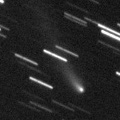
|
It reached up to 14 mag in 2010 autumn and winter. Now it is fading. In the Southern Hemisphere, it keeps observable in good condition while fading gradually. In the Northern Hemisphere, it will never be observable again.
Date(TT) R.A. (2000) Decl. Delta r Elong. m1 Best Time(A, h)
July 9 5 44.62 -31 5.8 3.740 3.305 57 16.0 5:37 (290, 28)
July 16 5 50.84 -33 2.2 3.721 3.337 60 16.0 5:36 (290, 33)
|
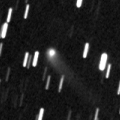
|
Now it is 15.9 mag (June 27, P. Dupouy). It will be fading very slowly after this. In the Northern Hemisphere, it keeps observable for a long time until 2012 spring when it fades down to 17-18 mag. It will not be observable in the Southern Hemisphere.
Date(TT) R.A. (2000) Decl. Delta r Elong. m1 Best Time(A, h)
July 9 22 57.44 51 52.4 4.933 5.050 90 16.0 3:52 (180, 3)
July 16 22 57.34 52 22.2 4.892 5.075 94 16.0 3:24 (180, 3)
|

|
Now it is 17.5 mag (July 5, Hidetaka Sato). It will approach to the earth down to 0.06 A.U. and brighten up to 7-8 mag in mid August. It will brighten rapidly after this. In the Northern Hemisphere, it is observable until early August when it brightens up to 10 mag. Then it goes away to the southern sky and becomes unobservable temporarily But it appears in the morning sky again at 7 mag in mid September, then it keeps observable while fading gradually. In the Southern Hemisphere, it is observable until mid August when it brightens up to 8 mag. But after that, it is not observable until winter when it becomes fainter than 16 mag.
Date(TT) R.A. (2000) Decl. Delta r Elong. m1 Best Time(A, h)
July 9 21 41.08 -19 46.8 0.579 1.528 144 17.2 2:36 (180, 75)
July 16 21 46.30 -21 4.2 0.461 1.436 150 16.1 2:13 (180, 76)
|
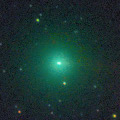
|
It approached to the sun down to 0.88 A.U. in mid April, and it brightened up to 8.6 mag (Apr. 13, Juan Jose Gonzalez). Now it is fading. It has already faded down to 15.3 mag by CCD observations (July 4, Hidetaka Sato). However, it is still very bright visually as 11.5 mag (July 9, Sandor Szabo). It will get diffuse and fade out rapidly after this.
Date(TT) R.A. (2000) Decl. Delta r Elong. m1 Best Time(A, h)
July 9 2 19.86 16 43.9 1.731 1.648 68 16.2 5:37 (208, 33)
July 16 2 29.07 16 38.6 1.745 1.739 72 16.8 5:36 (204, 35)
|
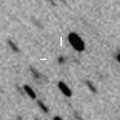
|
Now it is 16.0 mag (July 6, C. Rinner, F. Kugel). It will brighten up to 16 mag from summer to autumn, and will be observable in good condition.
Date(TT) R.A. (2000) Decl. Delta r Elong. m1 Best Time(A, h)
July 9 16 9.19 -1 54.5 1.367 2.177 131 16.2 21:01 (180, 57)
July 16 16 9.77 -2 30.6 1.400 2.157 125 16.2 20:34 (180, 58)
|
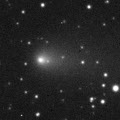
|
It became bright as 12 mag in 2010. Now it is fading. It has already faded down to 17.2 mag (July 5, Hidetaka Sato).
Date(TT) R.A. (2000) Decl. Delta r Elong. m1 Best Time(A, h)
July 9 2 4.03 3 50.5 3.690 3.587 76 16.3 5:37 (210, 47)
July 16 2 8.59 4 7.2 3.611 3.607 81 16.3 5:36 (203, 48)
|

|
Now it is 17.1 mag (June 24, J. F. Hernandez). It will brighten up to 13 mag in next winter. But the condition of this apparition is bad, and it will not be observable around the perihelion passage. It will be observable until July when it brightens up to 16 mag in the Northern Hemisphere, or until September when it brightens up to 15 mag in the Southern Hemisphere.
Date(TT) R.A. (2000) Decl. Delta r Elong. m1 Best Time(A, h)
July 9 11 17.96 11 19.7 2.459 2.136 59 16.4 18:32 (137, 33)
July 16 11 28.35 9 47.6 2.489 2.098 56 16.3 18:35 (132, 31)
|
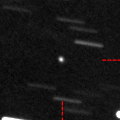
|
It is expected to be bright as 9 mag from 2012 to 2013. Now it is 16.7 mag (June 19, Toshiyuki Takahashi). In the Northern Hemisphere, although it becomes low temporarily in 2011 autumn, it keeps observable in good condition for a long time until 2012 autumn when the comet brightens up to 10 mag. In the Southern Hemisphere, it is hardly observble before the perihelion passage. But it becomes observable in good condition since 2013 after the perihelion passage.
Date(TT) R.A. (2000) Decl. Delta r Elong. m1 Best Time(A, h)
July 9 11 44.18 57 56.1 6.524 6.075 59 16.4 18:32 (165, -6)
July 16 11 48.85 56 57.6 6.507 6.017 57 16.4 18:35 (161, -7)
|
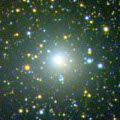
|
It reached up to 7.7 mag in 2009 summer (2009 Aug. 13, Chris Wyatt). Now it is fading. It has already faded down to 15.3 mag (June 29, Hidetaka Sato). It will never be observable again in the Northern Hemisphere. In the Southern Hemisphere, it keeps observable in good condition until 2011 autumn when it becomes fainter than 18 mag.
Date(TT) R.A. (2000) Decl. Delta r Elong. m1 Best Time(A, h)
July 9 15 50.58 -64 7.2 6.461 7.120 127 16.5 20:42 ( 0, 61)
July 16 15 42.02 -63 33.2 6.568 7.168 122 16.6 20:06 ( 0, 61)
|

|
New comet. Now it is 17.6 mag (June 29, Hidetaka Sato). In the Southern Hemisphere, it keeps observable at 16-17 mag for a long time from summer to winter. It is not observable in the Northern Hemisphere.
Date(TT) R.A. (2000) Decl. Delta r Elong. m1 Best Time(A, h)
July 9 22 39.92 -51 0.1 1.602 2.392 130 16.8 3:35 ( 0, 74)
July 16 22 32.93 -57 37.0 1.539 2.345 132 16.6 3:01 ( 0, 68)
|
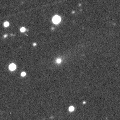
|
Now it is 16.5 mag (July 2, J. F. Hernandez). It was observed around 16 mag in 2009 and 2010. In 2011, it keeps observable at 17 mag from spring to autumn. It locates somewhat low in the Northern Hemisphere.
Date(TT) R.A. (2000) Decl. Delta r Elong. m1 Best Time(A, h)
July 9 16 59.19 -23 36.5 3.267 4.177 149 17.0 21:51 (180, 79)
July 16 16 56.15 -23 38.0 3.334 4.186 142 17.1 21:20 (180, 79)
|
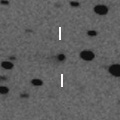
|
Now it is 17.3 mag (June 26, Hidetaka Sato). It keeps observable at 17 mag for a long time from 2011 to 2012.
Date(TT) R.A. (2000) Decl. Delta r Elong. m1 Best Time(A, h)
July 9 1 2.49 19 1.5 8.050 8.020 84 17.1 5:37 (186, 36)
July 16 1 0.52 19 7.7 7.928 8.021 91 17.0 5:27 (180, 36)
|

|
Appearing in the morning sky. It will brighten rapidly, and will be obserbale at 14 mag in good condition in autumn. It locates somewhat low in the Southern Hemisphere.
Date(TT) R.A. (2000) Decl. Delta r Elong. m1 Best Time(A, h)
July 9 3 47.65 4 19.3 2.229 1.798 52 17.3 5:37 (237, 32)
July 16 4 6.54 5 8.6 2.149 1.755 53 17.1 5:36 (235, 32)
|

|
Now it is 17.4 mag (June 24, J. F. Hernandez). It will brighten up to 15 mag in autumn and winter. But the condition of this apparition is bad. It is not observable around the perihelion passage. It will be getting lower in the evening sky after this. In the Southern Hemisphere, it will be observable until September when it brightens up to 16 mag. In the Northern Hemisphere, it will be unobservable soon.
Date(TT) R.A. (2000) Decl. Delta r Elong. m1 Best Time(A, h)
July 9 11 48.15 -7 52.7 2.194 2.154 74 17.4 18:32 (130, 53)
July 16 11 57.70 -8 42.1 2.230 2.114 70 17.2 18:35 (123, 50)
|
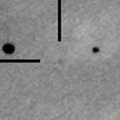
|
Now it is 17.1 mag (July 6, C. Rinner, F. Kugel). It is observable at 17 mag for a long time from 2011 to 2013. In 2011, it is observable in good condition in summer.
Date(TT) R.A. (2000) Decl. Delta r Elong. m1 Best Time(A, h)
July 9 17 9.04 3 54.2 5.247 6.064 140 17.4 22:00 (180, 51)
July 16 17 1.76 3 46.6 5.296 6.046 133 17.4 21:25 (180, 51)
|

|
New comet. Now it is 17.8 mag (July 5, L. Tesi, P. Bacci, G. Fagioli). Good condition in the Southern Hemisphere. It will be getting higher also in the Northern Hemisphere. But it will fade out rapidly. It will be fainter than 18 mag in late July.
Date(TT) R.A. (2000) Decl. Delta r Elong. m1 Best Time(A, h)
July 9 15 38.86 -20 28.8 2.241 3.007 130 17.5 20:31 (180, 75)
July 16 15 37.76 -18 33.7 2.369 3.051 123 17.7 20:02 (180, 73)
|
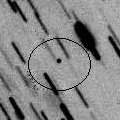
|
Peculiar asteroid moving along a comet-like retrograde orbit. Now it is 17.2 mag (July 1, C. Bell). It will be at opposition and observable at 17.5 mag in June and July. It has already passed the perihelion in January.
Date(TT) R.A. (2000) Decl. Delta r Elong. m1 Best Time(A, h)
July 9 19 14.04 -13 53.5 1.708 2.718 171 17.7 0:11 (180, 69)
July 16 18 49.09 -13 22.8 1.784 2.780 165 17.9 23:11 (180, 68)
|
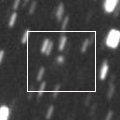
|
Now it is 16.6 mag (June 21, Hidetaka Sato). In the Northern Hemisphere, it keeps observable at 17 mag in good condition until summer. It locates low in the Southern Hemisphere.
Date(TT) R.A. (2000) Decl. Delta r Elong. m1 Best Time(A, h)
July 9 14 51.71 39 46.6 4.130 4.311 93 17.8 19:43 (180, 15)
July 16 14 43.36 38 43.6 4.244 4.336 88 17.9 19:07 (180, 16)
|

|
New comet. In the Southern Hemisphere, it is observable at 18 mag in good condition in July. In the Northern Hemisphere, it locates extremely low.
Date(TT) R.A. (2000) Decl. Delta r Elong. m1 Best Time(A, h)
July 9 14 6.15 -38 26.5 2.293 2.864 114 17.9 18:59 ( 0, 87)
July 16 14 13.21 -36 54.3 2.339 2.841 109 17.9 18:38 ( 0, 88)
|
|
![]()
 C/2010 X1 ( Elenin )
C/2010 X1 ( Elenin ) 62P/Tsuchinshan 1
62P/Tsuchinshan 1 C/2011 M1 ( LINEAR )
C/2011 M1 ( LINEAR ) C/2010 G2 ( Hill )
C/2010 G2 ( Hill ) 213P/2009 B3 ( Van Ness )
213P/2009 B3 ( Van Ness ) C/2009 F4 ( McNaught )
C/2009 F4 ( McNaught ) C/2011 L3 ( McNaught )
C/2011 L3 ( McNaught ) C/2006 S3 ( LONEOS )
C/2006 S3 ( LONEOS ) 29P/Schwassmann-Wachmann 1
29P/Schwassmann-Wachmann 1 (596) Scheila
(596) Scheila 73P/Schwassmann-Wachmann 3
73P/Schwassmann-Wachmann 3 C/2009 Y1 ( Catalina )
C/2009 Y1 ( Catalina ) 78P/Gehrels 2
78P/Gehrels 2 174P/(60558) 2000 EC98 ( Echeclus )
174P/(60558) 2000 EC98 ( Echeclus ) 48P/Johnson
48P/Johnson C/2011 A3 ( Gibbs )
C/2011 A3 ( Gibbs ) C/2010 M1 ( Gibbs )
C/2010 M1 ( Gibbs ) C/2010 S1 ( LINEAR )
C/2010 S1 ( LINEAR ) 9P/Tempel 1
9P/Tempel 1 130P/McNaught-Hughes
130P/McNaught-Hughes C/2010 B1 ( Cardinal )
C/2010 B1 ( Cardinal ) C/2008 FK75 ( Lemmon-Siding Spring )
C/2008 FK75 ( Lemmon-Siding Spring ) 45P/Honda-Mrkos-Pajdusakova
45P/Honda-Mrkos-Pajdusakova C/2011 C1 ( McNaught )
C/2011 C1 ( McNaught ) 115P/Maury
115P/Maury 65P/Gunn
65P/Gunn 71P/Clark
71P/Clark C/2011 F1 ( LINEAR )
C/2011 F1 ( LINEAR ) C/2006 W3 ( Christensen )
C/2006 W3 ( Christensen ) C/2011 L2 ( McNaught )
C/2011 L2 ( McNaught ) 74P/Smirnova-Chernykh
74P/Smirnova-Chernykh C/2008 S3 ( Boattini )
C/2008 S3 ( Boattini ) 49P/Arend-Rigaux
49P/Arend-Rigaux 37P/Forbes
37P/Forbes C/2010 R1 ( LINEAR )
C/2010 R1 ( LINEAR ) C/2011 L1 ( McNaught )
C/2011 L1 ( McNaught ) 2009 YS6
2009 YS6 C/2009 UG89 ( Lemmon )
C/2009 UG89 ( Lemmon ) C/2011 N2 ( McNaught )
C/2011 N2 ( McNaught )![]()

























